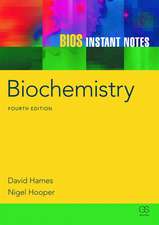Biology of Cellular Transducing Signals: Gwumc Department of Biochemistry and Molecular Biology Annual Spring Symposia
Editat de Jack Y. Vanderhoeken Limba Engleză Paperback – 14 oct 2011
Preț: 399.50 lei
Nou
Puncte Express: 599
Preț estimativ în valută:
76.45€ • 80.02$ • 63.63£
76.45€ • 80.02$ • 63.63£
Carte tipărită la comandă
Livrare economică 31 martie-14 aprilie
Preluare comenzi: 021 569.72.76
Specificații
ISBN-13: 9781461278665
ISBN-10: 146127866X
Pagini: 432
Ilustrații: 428 p.
Dimensiuni: 170 x 244 x 23 mm
Greutate: 0.69 kg
Ediția:Softcover reprint of the original 1st ed. 1990
Editura: Springer Us
Colecția Springer
Seria Gwumc Department of Biochemistry and Molecular Biology Annual Spring Symposia
Locul publicării:New York, NY, United States
ISBN-10: 146127866X
Pagini: 432
Ilustrații: 428 p.
Dimensiuni: 170 x 244 x 23 mm
Greutate: 0.69 kg
Ediția:Softcover reprint of the original 1st ed. 1990
Editura: Springer Us
Colecția Springer
Seria Gwumc Department of Biochemistry and Molecular Biology Annual Spring Symposia
Locul publicării:New York, NY, United States
Public țintă
ResearchCuprins
I — Receptors.- 1. Real—Time Analysis of Macromolecular Assembly During Cell Activation.- 2. Identification of Residues Essential for the Active Conformation of the ?-Adrenergic Receptor by Site—Directed Mutagenesis.- 3. Mechanisms for Diversification of Responses of Human Polymorphonuclear Leukocytes to Leukotrienes.- 4. The Role of Covalent and Non—covalent Mechanisms in Insulin Receptor Action.- 5. EGF Triggers A Similar Signalling Cascade in Different Cell Types Overexpressing the EGF Receptor.- 6. Second Messenger Receptors in the Phosphoinositide Cycle.- 7. Mechanisms of Receptor Regulation for the Phosphoinositide Signalling System.- 8. Computer Simulation of Prostaglandin—Regulated Cyclic AMP Metabolism in Platelets: Activation and Desensitization of Adenylate Cyclase Appear to be Mediated Through Separate Prostaglandin Receptors Coupled to Gs and Gi.- II — G Proteins.- 9. The Family of G Proteins.- 10. Roles of G Protein Subunits in Coupling of Receptors to Ionic Channels and Other Effector Systems.- 11. Receptor—Mediated Alterations of Calcium Channel Function in the Regulation of Neurosecretion.- 12. Antibodies as Probes of G—Protein Structure and Function.- 13. Transducin: A Model of Biological Coupling Enzymes.- 14. Co—Localization by Immunofluorescence of the ? subunit(s) of Gi with Cytoplasmic Structures.- 15. “Cross-Talk” and the Regulation of Hepatocyte Adenylate Cyclase Activity: Desensitization, Gi and Cyclic AMP Phosphodiesterase Regulation.- 16. Activation of Human Neutrophils by Granulocyte—Macrophage Colony—Stimulating Factor: Role of Guanine—Nucleotide Binding Proteins.- 17. Cytoskeletal Participation in the Signal Transduction Process: Tubulin G Protein Interactions in the Regulation of Adenylate Cyclase.- 18.Initiation and Modulation of Signal Output from the T cell Antigen Receptor.- 19. Selective Phosphorylation of a G Protein within Permeabilized and Intact Platelets Caused by Activators of Protein Kinase C.- 20. G Proteins and Toxin-Catalyzed ADP-Ribosylation.- 21. Novel Endogenous ADP—Ribosylations of Proteins in Transformed Cells: Effects of Cellular Transformation and Differentiation.- III — Inositol Phosphates.- 22. Inositol 1,4,5—Trisphosphate and Inositol 1,3,4,5—Tetrakisphosphate: Two Second Messengers in a Duet of Calcium Regulation.- 23. The Role of Endogenously Stimulated Protein Kinase C in Regulating Inositol Polyphosphate Accumulation in Human Platelets.- 24. Leukotriene D4 Increases the Metabolism of an Inositol Tetrakisphosphate-Containing Phospholipid in U937 Cells.- IV — Kinases.- 25. Immunocytochemical Localization of Protein Kinase C.- 26. A Protein Kinase C Pseudosubstrate Peptide Blocks G—Protein and Mitogenic Lectin Induced Phosphorylation of the CD3 Antigen in Human T—Lymphocytes.- 27. Growth Factor—Stimulated Tyrosine Phosphorylation of Phospholipase C.- V — Phospholipases.- 28. Eicosanoid Formation and Regulation of Phospholipase A2.- 29. Inhibition of Phospholipase A2 Activation in P388D1 Macrophage—like Cells.- 30. The Role of GTP—Binding Proteins in the Regulation of Phospholipase A2 and C in Bovine Retinal Rod Outer Segments.- 31. Stimulus—Coupled Activation of Phospholipase D.- VI — Calcium.- 32. The Orchestration of Stimulatory Signals for Secretion in Rat Basophilic Leukemia (RBL-2H3) Cells.- 33. Synchronized Ca2+ Transients induced by Glucagon in Fura2 Loaded Hepatocytes.- 34. Calcium Mobilization Mechanisms in Bovine Chromaffin Cells by Vasoactive Peptides: Angiotensin, Bradykinin and Endothelin.- 35.Influence of GDP(B)S on Agonist—Induced Calcium Mobilization and Platelet Function.- VII — Eicosanoids.- 36. Regulation of the Production of Lipoxygenase Products and the Role of Eicosanoids in Signal Transduction.- 37. Eicosanoid Synthesis in Resident Macrophages: Role of Protein Kinase C.- 38. Modulation of the S—K+ Channel of Aplysia Sensory Neurons by Lipoxygenase Metabolites of Arachidonic Acid and cAMP.- 39. Inhibition of Leukotriene D4 Mediated Release of Prostacyclin Using Antisense DNA.- VIII -- Glycosylated Phosphoinositides.- 40. Second Messengers of Insulin Action.- 41. Control by TSH of the Production by Thyroid Cells of an Inositol Phosphateglycan, Putative Mediator of the cAMP—Independent Effects in the Gland.






















